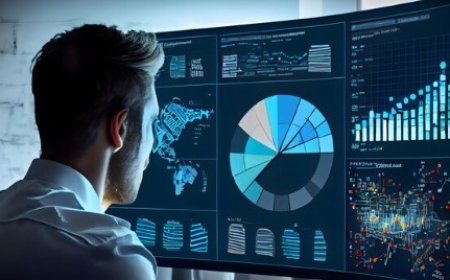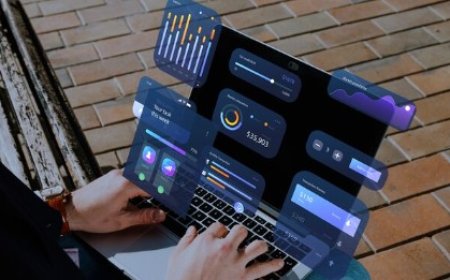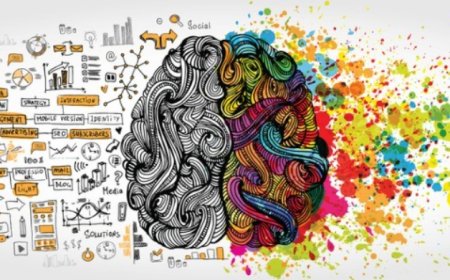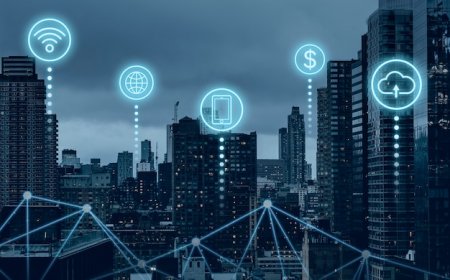The combination of analytics and the Internet of Things (IoT) is changing how industries operate in the modern digital age. Analytics uses data analysis and interpretation to acquire insights and make educated decisions, whereas IoT refers to a network of connected devices that can collect and share data. Their intersection is crucial in promoting digital transformation across sectors. Analytics helps us understand the data generated by IoT devices. This understanding is crucial because it allows businesses to make smarter decisions, improve operations, and even create new products and services.
UNDERSTANDING ANALYTICS AND IOT
Analytics is all about making sense of data. It helps organizations see patterns, trends, and insights in the vast amounts of information they gather. By understanding this data better, businesses can make smarter decisions, improve processes, and find new growth opportunities. On the other hand, IoT is about connecting devices to the internet. These devices could be anything from smartphones and sensors to machinery and appliances. IoT enables these devices to collect and share data, creating a network of interconnected things.
The relationship between Analytics and IoT is essential. While IoT devices collect tons of data, it's through analytics that this data becomes valuable. Analytics helps businesses understand what the data means and how they can use it.
TYPES AND COMPONENTS
Analytics in the context of IoT means using data analysis to understand and derive insights from the information collected by interconnected devices. It's about making sense of the massive amounts of data produced by IoT devices to improve decision-making and drive efficiency.
There are three main types of analytics used in IOT:
Descriptive Analytics: This type of analysis focuses on summarizing historical data to provide insights into what has happened in the past. It helps in understanding the current state of affairs and identifying trends and patterns.
Predictive Analytics: Predictive analytics uses historical data and statistical algorithms to forecast future outcomes or trends. It helps businesses anticipate potential issues or opportunities before they occur, enabling proactive decision-making.
Prescriptive Analytics: Prescriptive analytics goes beyond predicting future outcomes by recommending actions to optimize processes or achieve desired outcomes. It combines data analysis with optimization techniques to provide actionable recommendations.
Key Components of Analytics in IoT Systems
Data Collection: The first step in analytics is collecting data from IoT devices. This involves gathering information from sensors, devices, or other sources and transmitting it to a central repository for analysis.
Data Processing: Once collected, the data goes through processing to clean, filter, and organize it for analysis. This step ensures that the data is accurate and reliable for generating insights.
Data Analysis: Data analysis involves applying statistical techniques, machine learning algorithms, or other analytical methods to extract meaningful insights from the data. It helps in identifying patterns, correlations, and trends that can inform decision-making.
Insights Generation: Insights are derived from the analyzed data, providing valuable information about the current state of affairs, potential future outcomes, or areas for improvement.
Actionable Recommendations: Finally, based on the insights generated, actionable recommendations are provided to stakeholders. These recommendations guide decision-making and help in optimizing processes or addressing challenges effectively.
Analytics in IoT involves understanding data collected from interconnected devices to derive insights and make informed decisions. By employing descriptive, predictive, and prescriptive analytics, businesses can harness the power of data to drive efficiency and innovation in various industries.
APPLICATIONS OF ANALYTICS AND IOT
Analytics and IOT work together to help companies in different industries use data from connected devices to make better decisions and improve how they do things. This combination makes operations smoother, helps them work better, and brings new ideas. Let's see how they're changing some important areas:
A. Smart Manufacturing:
In smart manufacturing, IoT sensors collect data from machines and equipment. This data is analyzed to improve production processes, predict when maintenance is needed, and ensure products are made correctly. It helps factories run more smoothly and saves money by avoiding breakdowns.
B. Healthcare:
In healthcare, IoT devices like wearable trackers gather information about patients' health. Analytics helps doctors and nurses keep track of patients' conditions, make better treatment plans, and even predict when someone might get sick. It helps keep people healthy and saves money by avoiding unnecessary hospital visits.
C. Transportation and Logistics:
In transportation and logistics, IoT sensors in vehicles and warehouses collect data about where things are and how they're doing. Analytics helps companies plan better routes, keep vehicles running smoothly, and make sure deliveries arrive on time. It saves money by using fuel more efficiently and reducing delays.
D. Smart Cities:
In smart cities, IoT sensors gather data about things like traffic and air quality. Analytics helps city planners make decisions about where to put roads, parks, and other things to make cities better places to live. It saves money by using resources like water and electricity more efficiently.
E. Agriculture:
In agriculture, IoT devices in fields gather data about things like soil moisture and weather. Analytics helps farmers decide when to water crops, when to plant, and when to harvest. It saves money by using resources like water more efficiently, which helps farmers grow more food.
F. Energy Management:
In energy management, IoT meters track how much energy buildings and factories use. Analytics helps businesses figure out where they can save energy, like by turning off lights when they're not needed. It saves money by using less energy, and it helps protect the environment by reducing pollution.
CHALLENGES AND SOLUTIONS
Using analytics and IoT has its hurdles, but there are ways to overcome them. Here's a look at some common problems and how to solve them:
Integration of analytics and IoT poses several challenges, but with strategic solutions, organizations can overcome them effectively.
A. Data Security and Privacy Concerns:
- Ensuring the security and privacy of data collected by IoT devices is paramount.
- Solutions include employing robust encryption methods, implementing access controls, and conducting regular security audits to protect sensitive information.
B. Scalability Issues:
- As the volume of data generated by IoT devices increases, scalability becomes a concern.
- Solutions involve adopting scalable infrastructure and cloud services that can accommodate growing data loads without compromising performance.
C. Integration Complexity:
- Integrating diverse IoT devices and analytics systems can be complex.
- Solutions include using standardized protocols and APIs, adopting modular architectures, and investing in middleware solutions to facilitate seamless integration and interoperability.
D. Real-time Processing Requirements:
- Certain applications require real-time data processing capabilities.
- Solutions include deploying edge computing solutions to process data closer to its source, reducing latency, and meeting real-time processing needs without overwhelming central systems.
E. Skill Gap and Workforce Training:
- The shortage of skilled professionals with expertise in analytics and IoT presents a challenge.
- Solutions involve investing in workforce development programs, providing training opportunities for existing staff, and collaborating with educational institutions to cultivate talent.
F. Regulatory Compliance:
- Compliance with data protection regulations such as GDPR and CCPA is critical.
- Solutions include implementing robust compliance frameworks, conducting regular audits, and staying abreast of evolving regulatory requirements to ensure adherence.
G. Solutions and Best Practices:
To address these challenges effectively, organizations should prioritize data security, invest in scalable infrastructure, streamline integration processes, foster workforce development, and maintain compliance with relevant regulations.
By proactively addressing these challenges and implementing appropriate solutions and best practices, organizations can successfully integrate analytics and IoT to drive innovation and achieve their business objectives.
CASE STUDIES
Let's see how analytics and IoT are making a difference in different areas:
A. Industrial IoT in Manufacturing:
In factories, IoT sensors keep an eye on machines. By looking at this data, companies can find ways to make things run better, fix problems before they happen, and make sure products are made right.
B. Healthcare Analytics:
Doctors use devices that track patients' health. By checking this data, they can see how patients are doing, find patterns, and give better treatment. For example, hospitals might use these devices to watch patients' vital signs and act quickly if something's wrong, which helps patients stay healthy and avoid more hospital visits.
C. Smart Agriculture:
Farmers use sensors to watch over their crops. By checking this data, they can decide when to water, spot problems early, and grow more food. For instance, they might use sensors to see if the soil is dry and adjust watering, saving water and getting better crops.
D. Transportation and Logistics:
Companies that move things around use sensors to keep track of them. By looking at this data, they can find better routes, use less fuel, and get things where they need to go on time. For example, they might use sensors to see where delivery trucks are and find the fastest way to deliver packages, which makes customers happy.
E. Smart City Initiatives:
Cities use sensors to watch what's happening in the city. By using this data, they can make better plans, cut down on pollution, and make life better for people who live there. For instance, they might use sensors to check how clean the air is and change how traffic flows to make it cleaner and less crowded, which makes the city a nicer place to be.
In short, analytics and IoT help in lots of different ways, from making factories run better to keeping cities clean and people healthy.
FUTURE TRENDS AND PREDICTIONS
Looking ahead, the future of analytics and IoT promises exciting developments that will reshape how we use data and technology. Here's a brief overview of some key trends:
A. Edge Analytics and Edge Computing:
Edge analytics and computing involve processing data closer to where it's generated, reducing delays, and saving bandwidth. This trend will likely become more common as demand grows for faster data analysis, especially in remote areas or places with limited internet access.
B. AI and Machine Learning Integration:
AI and machine learning will play a bigger role in analytics and IoT, allowing for more advanced data analysis and predictions. This integration will lead to better automation, the detection of unusual patterns, and personalized experiences driven by AI algorithms.
C. Blockchain in IoT Analytics:
Blockchain technology offers a secure way to record and verify transactions, making it useful for ensuring trust in IoT data exchange. In the future, we may see more use of blockchain to guarantee data integrity and security in IoT ecosystems.
D. Ethical Considerations and Responsible AI:
As analytics and AI become more widespread, ethical concerns about data privacy, bias, and accountability will become increasingly important. Organizations will need to focus on ethical practices and responsible AI principles to ensure the fair and transparent use of data.
E. Quantum Computing Implications:
Quantum computing has the potential to revolutionize analytics and IoT by enabling faster data processing and solving complex problems. However, widespread adoption is still in the early stages and will require significant advancements in technology and infrastructure.
Key Takeaways:
-
Analytics and IoT help organizations get insights from data collected by devices.
-
They improve decision-making, operations, and innovation in many industries.
-
Important applications include manufacturing, healthcare, transportation, cities, agriculture, and energy.
-
Challenges like data security and scalability need to be addressed for successful integration.
In the future, we'll see more advancement in analytics and IoT working together. This includes faster processing, better security, and new technologies like AI and blockchain. Organizations that embrace these changes will stay ahead of the curve and succeed in their industries.
Businesses need to embrace the analytics-IoT revolution and invest in technologies that make integration easier. By using data to make decisions, encouraging new ideas, and keeping up with trends, companies can grow and lead the way in their fields.
Analytics and IoT are a powerful combination that can transform industries. By using them wisely, businesses can improve how they work and find new opportunities for success.







